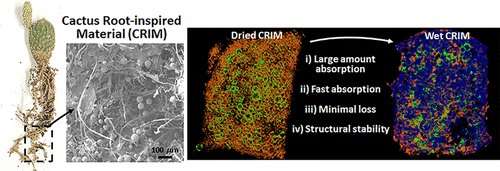Cactus roots inspire creation of water-retaining material

During rare desert rainfalls, cacti waste no time sopping up and storing a storm's precious precipitation. Inspired by this natural phenomenon, scientists report in a study appearing ACS Macro Letters that they have developed a material that mimics cactus roots' ability to rapidly absorb and retain vast amounts of water with a minimal amount of evaporation. They say this unique material could lead to new and improved cosmetics, medical devices and other everyday products.
Like all living things, cacti need water to survive. Yet they thrive in some of the world's driest places. The key is the plant's shallow, but extensive root system that quickly soaks up rainfall, which seldom penetrates more than just a few inches into the soil. During droughts, the roots dehydrate and shrink, creating air gaps that prevent water from escaping back into the soil. Intrigued by these traits, Sang Joon Lee, Hyejeong Kim and Junho Kim wanted to create a durable material that could effectively absorb and store water, without changing other physical properties.
The research team sought to replicate the key features of the cactus root system. To imitate the cactus root and its outer covering, they made a material composed of cellulose fibers, agarose cyrogel and microparticles. Then, they made a cylindrical-shaped gel and freeze-dried it to form a structure that mimics the layered composition of cactus root epidermis. Laboratory tests suggest that the resulting cactus-root-inspired material (CRIM) is capable of absorbing water nearly 930 times faster than it loses through evaporation.
The researchers say the mixture of cellulose fibers, microparticles and cryogel is adjustable for particular needs. For example, adding water-repellant microparticles to this system could produce CRIMs useful in oil separation and other oil-based engineering processes. They conclude that CRIMs could eventually have a host of applications in agriculture, cosmetics and medicine.
More information: Hyejeong Kim et al. Fast and Efficient Water Absorption Material Inspired by Cactus Root, ACS Macro Letters (2018). DOI: 10.1021/acsmacrolett.8b00014
Abstract
Analogous to the morphological and functional features of cactus root, a novel cactus root-inspired material (CRIM) was fabricated by integrating cellulose fibers, microparticles, and agarose-based cryogels. Without undergoing sophisticated chemical synthesis or surface modification, the CRIM exhibited efficient water absorption and retention ability with high structural stability. 82% of the total water absorption capacity was recovered within 1 min, with a swelling rate nearly 930-fold faster than the evaporation rate, while only about 17% of the length extension occurred. Given that efficient water absorption and storage without physical change is crucial to the design and fabrication of water management devices, the CRIM is a promising material for various applications, including cosmetics or healthcare products, functional fabrics, and drug delivery devices.
Journal information: ACS Macro Letters
Provided by American Chemical Society




















